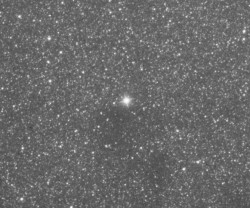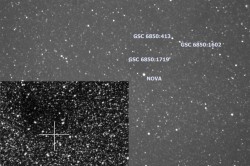Since the initial alert for the latest nova in Sagittarius, folks the world over have been anxious for darkness to arrive and their chance at spotting this cosmic wonder firsthand. Thanks to our good friends at Macedon Ranges Observatory, Universe Today readers are about to see the latest nova in Sagittarius revealed and learn just what is a nova.
One thing is certain, both professional and amateur astronomers have something in common – curiosity. Unfortunately, because many of us live where skies seem to be perpetually cloudy or don’t always have the equipment to view a late breaking astronomy alert object, it becomes even more imperative to be able to call upon others in different regions of the world. It certainly is a true pleasure to have friends down under! So now that we see it… What is a nova?
The word nova is Latin for “new star”. Astronomers assign the term nova to stars that have a rapid increase in brightness. These stars are usually far too dim to be seen unaided and may often become the brightest object – besides the Sun and Moon – in the sky!
Novae themselves are stars that have been quiet for many years, and suddenly decided to reignite their nuclear fusion process. All stars have fusion occurring in their core – processing hydrogen into helium and releasing energy. When this fuel is expended, stars like our sun simply shed their outer layer and continue on as small, hot, white dwarf stars. They are basically dead… Their fuel gone.
Unlike our own Sun, most stars are a binary system – two stars that closely orbit each other. If one of these stars should happen to be a white dwarf and the other starts to evolve into a red giant, the white dwarf can begin attracting gas towards itself by means of gravity. What type of gas? Hydrogen! When the hydrogen stolen from the red giant reaches the surface of the incredibly hot white dwarf, it rapidly ignites. What’s born is an incredibly huge nuclear explosion on the white dwarf’s surface and we see it as a nova!
Using a 12″ Ritchey Chretien Optical Systems telescope, Joe Brimacombe set to work imaging the latest nova for us to see. By comparing this photo with the 19 April Sagittarius Image you can see how quickly the white dwarf ignited!
Nova Sgr 19April2008 Joseph Brimacombe Image details are as follows: STL11000 camera; BRC 250; image scale 1.46 asec/px; image is 97 amin across; nova is centre star; stack 6 x 300 Ha; false colour.




What exactly is meant by the hydrogen “igniting” on the surface of a white dwarf. Does it mean that the hydrogen is “burning” in some sort of chemical oxidation process? Or is it undergoing fusion with other hydrogen on the surface of the white dwarf?
The article doesn’t make it clear enough by how much Nova Sgr 2008 has brightened since it was discovered: It is almost a naked-eye object now!
@ cynthia:
“igniting” —> fusing (as in fision)
pssst…. daniel….
maybe if you’d been following the whole story here on UT instead of just pointing back to your own webpage, you’d have noticed we’ve been imaging and reporting on the changes since the 19th of april.
at the risk of getting fired, either get your own stories or get off my back.
@ Tammy: Good fer ya girl!! If a person cannot find their own stories but, as you point out “… point back to their own webpage” then it seems that UT folks ARE doing their job and it’s unfortunate that others are just to d*** lazy to foot slog for themselves.
Fraser: Thanks for the hard work you guys… and gals 8) do here! Keep it up please!
Oh Tammy, it makes me want to buy a telescope and get out there! Wonderful observations – inspirational reporting.
(and good for you by the way, Daniel spends way too much time promoting his website than actually adding news, sad really)
Looking forward to seeing the next astronomy update (I’ll be one step closer to a brand new telescope then 😀 )
Cheers, Ian
Ahem… If I might make two corrections.
Firstly, “nova” does not mean “new star”, it just means “new”. The correct old term is “stella nova”. In the days of more or less naked eye observing, a stella nova was any star that appeeared out of nowhere. Today, a “nova” classifies, as you write, a binary system with a white dwarf that has accretion-induced fusion episodes.
Second comment: You write: “When the hydrogen stolen from the red giant reaches the surface of the incredibly hot white dwarf, it rapidly ignites. What’s born is an incredibly huge nuclear explosion on the white dwarf’s surface and we see it as a nova!” This is not totally correct. The hydrogen stream from the donor star is almost always steady (it fills its Roche lobe and then overflows). Furthermore, the surface temperature of the white dwarf has nothing to do with it – it may reach, in extreme cases, several hundred thousand Kelvin, but you need a temperature of many million Kelvin for fusion. What is important is the surface gravity, which is extremely high for white dwarfs. The stream of hydrogen accumulates on the surface of the white dwarf, forming a very dense hydrogen atmosphere. When the pressure and temperature at the bottom of this atmosphere reaches heights where fusion can take place, a thermonuclear reaction sets in, which then blazes through the atmosphere, fusing part and blowing the rest off.
This process repeats itself. Depending on different parameters, such as the accretion rate and the white dwarf mass, you get everything from many small eruptions separated by relatively short (years) timescales (dwarf novae) to huge blasts (which, like Nova Sgr 2008, increase the stars magnitude by more than 10) which might happen only every 10000 years.
Incidentally, the one explosion process – novae – staves off the other explosion process – Type Ia supernovae – because the novae explosions prevent the white dwarf from gaining mass and reaching the Chandrasekhar mass.
Hope this clears a few things up.
Alex
When I’m back in the US I’ll be sure to sign for one of your telescopes! 😀 I’ll have to pop to the desert though, damned LA lights and smog… That’s the great thing about reading your articles, lets me turn of my physics brain and get excited about actually observing the things I teach… I bet you’ll find a lot of frustrated astronomers in the UK – not many cloudless nights 🙁 In theory I can do astronomy…
Looking forward to your next virtual astronomy tour!
Ian 🙂
I don’t mind your comments a bit, Don. I’m sure if you regularly read my stuff that you’ve probably gathered this was “aimed down” for a slightly younger audience. So good for you for science-ing it up! 🙂
And thank you, Ian… That’s been coming for some time and I’m very happy to know that my friends think no less of me. Tell me where you live and I’ll send one of my scopes for you to try out… Bless UPS!
Since feed readers show newer stories first, this was the one I saw before the older “is brightening” story which was ‘below the fold’. It did not refer to the older one in the text (only the very first one) nor did it repeat the key fact (steep rise to 6.5 mag.).
Nor did it give a date for the new image shown (which also has a different exposure setting/grey scale than the April 19 pic, making a comparision hard). Nor does the link behind the observatory lead to the original images. Now who’s sloppy here …
By the way, an editing feature for one’s own comments would help a lot (most blogs provide it): There was no way to edit my remarks once I discovered the older story!
In any case the nova decided to take a dive immediately after the peak …
who cares, daniel?
anyhow, ian… when you have a chance to visit in the states, just contact me. i know people everywhere and we’ll get a scope into your hands. we take great joy and pleasure out of being friends and sharing our experiences and equipment!
i’ve just spent the last few days in New York doing some networking and i’m really looking forward to more new and exciting ways in which we can share real time astronomy with our readers – regardless of where you live and what your weather is like.
of course, you’ll have to not mind my sloppy the dates are perfect but they’re hidden so leeches couldn’t steal it too bad i have friends who were willing to image it where’s yours sometimes not always scientific enough to suit everybody but at least hey i’m doing it what’s your excuse brand of astronomy.
there’s always room for more friends at the eyepiece!
My ignorance is showing (it does often), but as I scroll through your pages (including the red link “subscribe”), I don’t see where I need to sign in to subscribe to Universe Today. Can you assist me?
Thank you (from Taiwan)(where I’m trying to encourage interest in Space programs).
John Dankowski
hi, john!
no worries. if you’d like to get the current news as a feed, you click on the subscribe button and it will allow you different options to choose what system works best for you and your website.
if this isn’t what you had in mind, look just below the search engine line, and you’ll find the email link. this will generate a news letter directly to your email that will allow you to click any link you wish to read futher into the stories. this feature is great if you don’t have a website because the news will come to your personally.
if there’s anything i can do to assist, please don’t hesitate to click my name and i’ll be happy to do what i can.
best to our friends in taiwan!
>ed Says:
>April 24th, 2008 at 3:51 pm
>@ cynthia:
>”igniting” —> fusing (as in fision)
haha fusion and fission aren’t exactly the same thing… more like the complete opposite. Next time you want to explain something to someone, ask yourself if it’s a topic you know the slightest thing about.